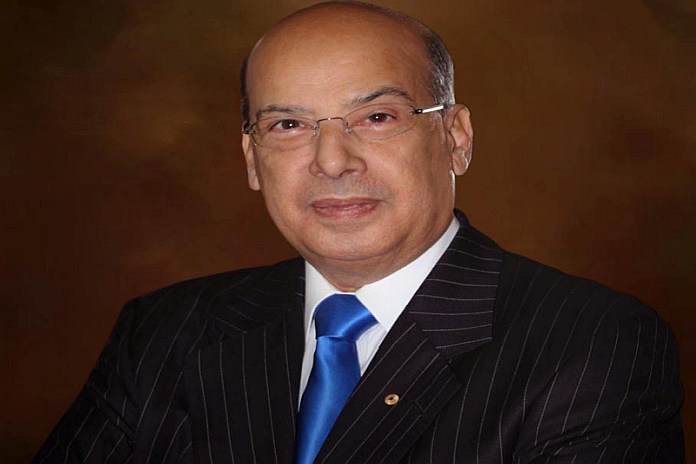By Sir Ronald Sanders
The presidents of Guyana and Suriname have announced two major joint venture projects whose implementation will deepen the beneficial relations between the two countries, and could have a positive effect for the 15-nation Caribbean Community (CARICOM) of which they are members.
The projects are a bridge across the Corentyne river to link the two countries, and the construction of a US$1 billion offshore base to support huge oil discoveries in the Guyana-Suriname basin of more than 10 billion barrels of oil.
Relations between the two countries have not always been harmonious. Land and sea territorial disputes have caused military skirmishes and tension in the past. Fortunately, successive governments of both territories were sufficiently restrained to stop short of a full-scale war – a marked difference with the other countries on the South American continent.
Peaceful resolution of disputes through negotiation and international arbitration, and active fostering of economic integration, have always been the best way forward for Guyana (formerly British Guiana) and Suriname (formerly Dutch Guiana). Along with French Guiana, they make up what used to be known as ‘The Three Guianas’, lying next to each other on the north-eastern coast of South America.
In the foreword to the book, “Post-Colonial Trajectories in the Caribbean: The Three Guianas”, published by Routledge in 2017, I wrote: “Guyana and Suriname are more similar to each other than they are to any of the member countries of CARICOM, except Trinidad and Tobago. Given the similarity of their resources which includes mining, agriculture, fisheries and oil, they would benefit enormously from the economic integration of their production, freedom of movement of goods and services, joint bargaining with foreign investors and the international community generally”.
I added: “If the governments of Guyana and Suriname – together with the private sectors of both countries – were to work diligently toward economic integration, the two countries could easily become a joint economic powerhouse, exporting their products globally”. In this connection, it is noteworthy that the Surinamese President, Chandrikapersad Santokhi, said that the US$1 billion offshore base “will extend also to the private sector so that we can have a public-private partnership approach”.
In pursuing joint venture projects that will strengthen their economic integration, the governments have sensibly not ignored their one remaining territorial dispute. Having settled their maritime boundary dispute in September 2007 under an arbitration by the United Nations Tribunal on the Law of the Sea, the governments have agreed that their joint Border Commission will continue to examine ways of resolving the land border dispute over an area known as ‘the New River Triangle’.
Guyana’s president Irfaan Ali, in noting that the “future of (the two) economies is intertwined”, also stated that “Guyana and Suriname are also part of the Caribbean Community”. He did not have to do so. His deliberate inclusion of this remark to the Suriname parliament, is an indication of the importance his government places on CARICOM. Even more indicative of Guyana’s commitment to CARICOM is president Ali’s further remark that “both states (should) take the lead in demonstrating the efficacy of regional integration”. “Together”, he said, “we can meet and fulfil a great portion of the food needs within the Caribbean community”.
President Ali is right, provided that the long-standing problem of sea and air transportation can be resolved to carry food between Suriname-Guyana and other countries in CARICOM. The regional group’s bill for the importation of food is now US$5 billion a year. It would be highly beneficial to the region’s food security and its retention of foreign exchange, if its member states could collectively devise at least a break-even financial operation for a shipping line. It is a project which Guyana and Suriname, in collaboration with Trinidad and Tobago, might consider underwriting through a portion of their oil and gas income.
Guyana and Suriname are expected to receive significant revenues in the coming years. Neither country has the absorptive capacity to utilize all the expected annual income, however free-spending they might be in building physical infrastructure, increasing the wages of their workforce, and improving health and education. They should be able to dedicate a portion of their revenues to invest in CARICOM projects and member states in ways that would strengthen the region, breaking its dependence on external powers and enhancing its integration.
None of this would be a give-away; it could be targeted investment in projects that provide financial returns for all the parties concerned, while accelerating development in CARICOM. In addition to food and related transportation, Suriname, Guyana and Trinidad and Tobago could consider, in consultation with other CARICOM states, how they could profitably underpin energy security for the region. That profit would be measured not only in financial terms, but also in the benefits of ending reliance on external countries and strengthening the sovereignty of the region in its decision-making.
Security of regional transportation, food and energy would be three important, immediate areas for Guyana and Suriname to “take the lead in demonstrating the efficacy of regional integration” to which president Ali referred.
The “dedicated pathway to deepen economic and social cooperation” between Guyana and Suriname should be applauded by all. Even as they pursue this path, from which both countries and their peoples will undoubtedly benefit, they should take the steps to examine how such cooperation can be extended to CARICOM.
The neighbourhood in which the people of Guyana and Suriname live would be more secure, and in that regard, so would they.





